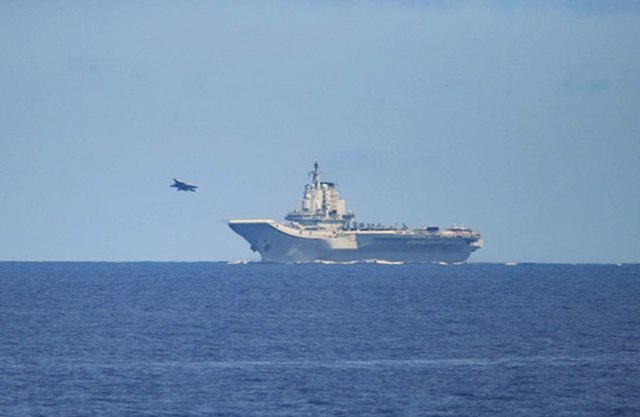It appears that the Chinese regime is incrementally increasing the scope and scale of its challenges to the sovereignty of Taiwan in addition to the continuous air and naval activity since December 2022, when President Joe Biden signed the National Defense Authorization Act (NDAA). The new law was replete with strong statements of support for Taiwan.
China has continued to assert that Taiwan has become a base for American military forces with the NDAA. Beijing opposed a recent trade agreement between Taiwan and the United States. And now, new Taiwan proposals by Congress are heightening the tenacity of Chinese histrionics.
China has introduced high-endurance drones to complement manned aircraft and operate independently to provide an omnipresent specter of presence around Taiwan. This was helpful during the Balikatan 23 exercises, where Chinese aircraft could conduct a maintenance reset after four months of increased flight operations tempo. The focus of the Chinese drone campaign seemed to be the Eastern shore of Taiwan facing the deep and broad Pacific—the most likely approach for ships and aircraft arriving to help resupply Taiwan in case the regime goes to the next step in attempting to constrict and asphyxiate Taiwan from the outside world.
In grand military strategy and tactics (and very Sun-Tzu-ian), China will need to distract and complicate the efforts of the United States and other countries from breaking the tightening Chinese blockade of Taiwan. There are three available opportunities for China to conduct a campaign of distraction from its blockade of Taiwan at a very low cost in terms of resources or military units.
Disabling the Panama Canal
The expansion of the Panama Canal has greatly increased merchant traffic, and approximately 6 percent of world trade passes through the canal. Chinese Belt and Road initiatives are omnipresent in Panama, while American participation in infrastructure or any mercantile activity has evaporated or dithered. One infrastructure development in Panama that China has been stalking is the water management system for the canal. With water levels diminishing and affecting traffic, there is an urgency to this initiative, and it has been announced, withdrawn, and re-announced. The United States Army Corps of Engineers has been awarded a contract for technical oversight of the project. However, the award of the overall construction and operation of the initiative is still in process. The reality is that water management is vital to keeping the Panama Canal open, and any water management accident, unintentionally or intentionally, can have catastrophic effects on the canal.
The effect of any blockage or slowdown of traffic through the canal would have a devastating economic impact on the United States. Still, it would also render almost half of the U.S. Navy unable to aid American and allied forces deterring China or helping to lift any possible blockade of Taiwan. The only solution for losing the canal would be to transit ships around the bottom of South America, potentially adding a month at a minimum to travel time to the Western Pacific. However, even at the tip of South America, China has suddenly appeared, and the U.S. Southern Command Commander expressed great concern about its ability to keep the Panama Canal and Straits of Magellan open to traffic in light of aggressive Chinese civil-military and Belt and Road strategies. The reality is that China is already in Panama and can apply decisive influence at will to the Panama Canal when it so desires.
Blocking Traffic Through the Suez Canal
Another vital canal is the Suez Canal. The United States can survive without the Suez Canal, but Europe will be greatly distressed by any long-term loss of use of the canal. The canal is irreplaceable in ensuring the flow of energy and routine consumer products necessary for basic functions of life in Europe. On the other hand, China—with new treaties with Saudi Arabia and Iran for energy and security arrangements—would be relatively unaffected by the closure of the Suez in the short term and assuming an outcome of world tensions favorable to China, a temporary diminishment of the outflow of Chinese consumer products to Europe would be worth it.
The expanding presence of Chinese forces at their dramatic and imposing fortress in Djibouti is the logical forward operating base for Chinese civil-military influence operations toward the Suez Canal. The Chinese base camp is only about 7 miles or 10 minutes at high speed from the long-standing American and coalition outpost at the international airport in Djibouti.
Advertisement - Story continues below
There is a stark difference in combat power between the Chinese and American-led units in this small country. The Chinese garrison forces have heavy armor, mobile artillery, and high-speed wheeled combat vehicles. In contrast, the American forces are largely humanitarian, logistics, and relatively lightly equipped Special Operations forces focused on projection south into Ethiopia, Somalia, and Kenya. The Chinese facility also has a large, dual-use port that can rapidly offload reinforcements. The presence of Chinese forces close to Egypt, which is also leaning Chinese, is influential and greater in strength than American or coalition forces. In addition, the possibility of China using economic incentives to Egypt to offset any loss to Egypt from diminished or stopped passage through the canal would be quite worth the roughly $10 billion that Egypt receives annually from canal passage fees.
Assailing US Domestic Critical Infrastructure
The possibility of a Chinese cyber blitz on American domestic critical infrastructure necessary to support the Defense Department projection of force toward the Western Pacific was already foreseen and articulated in FY 2023 NDAA Section 1088. Section 1088 requires a tabletop exercise to assess a Chinese cyber assault intended to disrupt, degrade, or destroy domestic U.S. infrastructure necessary to enable U.S. generation and projection of military force to intervene in a Chinese assault in the Western Pacific. China's three focus areas are likely power plants, ports, and U.S. defense industrial base plants.
While it is unclear as to the status of the mandated tabletop exercise, the Chinese regime has already begun the cyber preparation of the battlefield by being caught planting remote access software via Microsoft products on critical defense infrastructure in Guam. This provocative action by the regime only validates the concern of many national security analysts regarding the intent and direction of Beijing's ambitions.
By conducting coordinated efforts through Chinese companies, interests, and forces already in place to disrupt the use of the Panama Canal, the Suez Canal, and U.S. domestic infrastructure, the Chinese regime will be in a good position to significantly, and perhaps decisively, block any U.S. and allied nation actions to provide relief to a Taiwan under duress of Chinese Communist Party aggression.
Views expressed in this article are opinions of the author and do not necessarily reflect the views of The Epoch Times.
ColonelRetJohn Substack

























